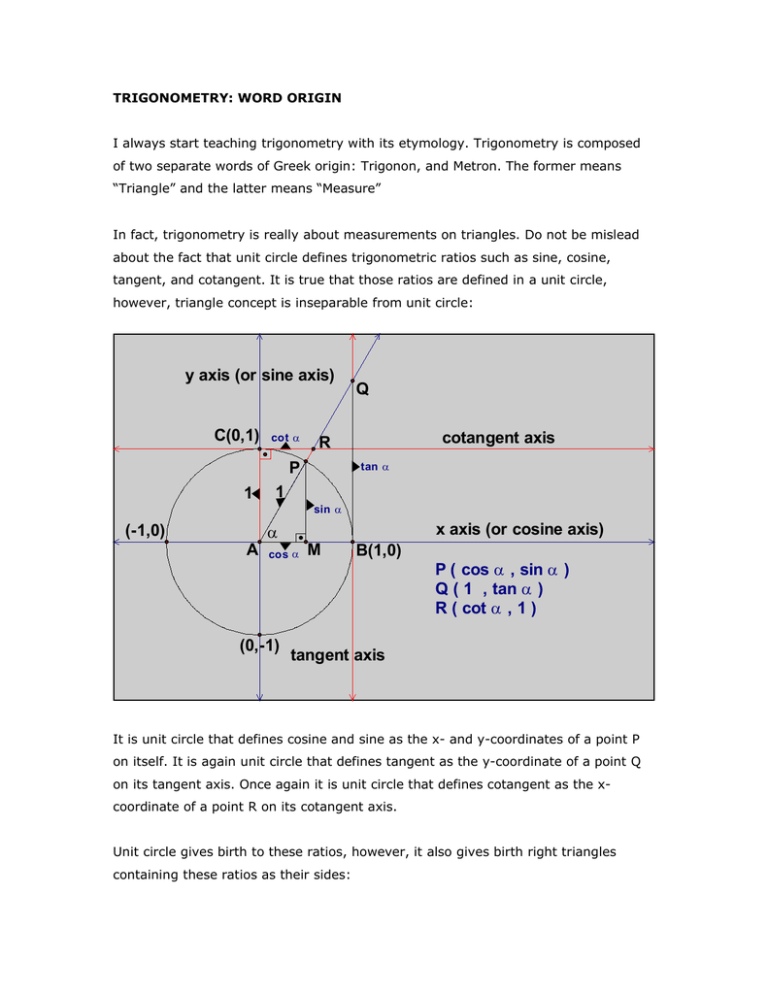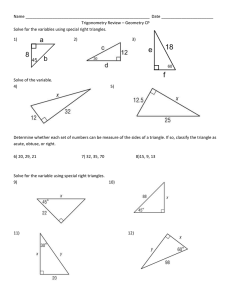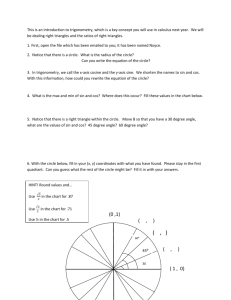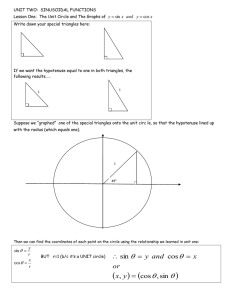1 y axis (or sine axis) x axis (or cosine axis) tangent axis cotangent
advertisement

TRIGONOMETRY: WORD ORIGIN I always start teaching trigonometry with its etymology. Trigonometry is composed of two separate words of Greek origin: Trigonon, and Metron. The former means “Triangle” and the latter means “Measure” In fact, trigonometry is really about measurements on triangles. Do not be mislead about the fact that unit circle defines trigonometric ratios such as sine, cosine, tangent, and cotangent. It is true that those ratios are defined in a unit circle, however, triangle concept is inseparable from unit circle: y axis (or sine axis) C(0,1) cot α (-1,0) A cotangent axis R P 1 Q tan α 1 sin α x axis (or cosine axis) α cos α (0,-1) M B(1,0) P ( cos α , sin α ) Q ( 1 , tan α ) R ( cot α , 1 ) tangent axis It is unit circle that defines cosine and sine as the x- and y-coordinates of a point P on itself. It is again unit circle that defines tangent as the y-coordinate of a point Q on its tangent axis. Once again it is unit circle that defines cotangent as the xcoordinate of a point R on its cotangent axis. Unit circle gives birth to these ratios, however, it also gives birth right triangles containing these ratios as their sides: Triangle AMP with right sides ∣AM ∣= cos ,∣MP∣= sin and hypotenuse ∣PA∣=1. Triangle ABQ with right sides ∣AB∣=1 ,∣BQ∣= tan and hypotenuse ∣QA∣. Triangle RCA with right sides ∣RC∣= cot ,∣CA∣=1 and hypotenuse ∣AR∣. Moreover, these right triangles are similar: AMP ~ ABQ ~ RCA Keep it in mind: Trigonometry is about unit circle and right triangle. If you are stuck, or in the middle of a crisis when trying to solve a trigonometry problem, do not worry: Immediately revise unit circle and the way it defines trigonometric ratios. Believe me, there is nothing more: Trigonometry is about unit circle. The following is a tree of logical propositions that I made: P1: Trigonometry is about unit circle P2: Unit circle defines trigonometric ratios P3: Unit circle defines right triangles containing these ratios as their sides. P4: These right triangles are similar triangles. P5: Similarity of these triangles yileds trigonometric equalities AKA identities sin 2 cos 2 =1 tan = sin cos cot = cos sin P6: Unit circle is about triangles and measurements on triangles P7: Trigonometry is about triangles and measurements on triangles Here is how I use these propositions as one conditional proposition: P1 ⇒ P2 ⇒ P3 ⇒ P4 ⇒ P5 ⇒ P6 ⇒ P7 And finally, I can write I can also write P1 ⇒ P6 ⇒ P7 P1 ⇒ P7 The last compound proposition in words says: “Trigonometry is about unit circle therefore Trigonometry is about triangles and measurements on triangles” Let's start then..


